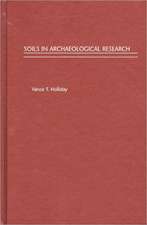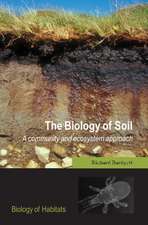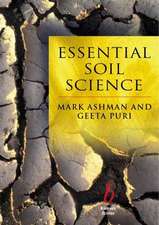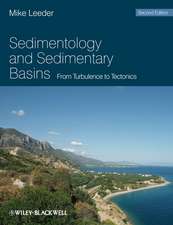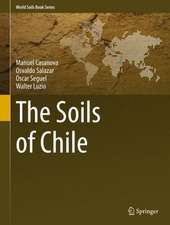Nitrogen Economy in Tropical Soils: Proceedings of the International Symposium on Nitrogen Economy in Tropical Soils, held in Trinidad, W.I., January 9–14, 1994: Developments in Plant and Soil Sciences, cartea 69
Editat de N. Ahmaden Limba Engleză Hardback – 31 oct 1996
| Toate formatele și edițiile | Preț | Express |
|---|---|---|
| Paperback (1) | 1568.54 lei 38-44 zile | |
| SPRINGER NETHERLANDS – 20 sep 2011 | 1568.54 lei 38-44 zile | |
| Hardback (1) | 1836.16 lei 6-8 săpt. | |
| SPRINGER NETHERLANDS – 31 oct 1996 | 1836.16 lei 6-8 săpt. |
Din seria Developments in Plant and Soil Sciences
- 18%
 Preț: 1225.94 lei
Preț: 1225.94 lei -
 Preț: 391.79 lei
Preț: 391.79 lei - 18%
 Preț: 1225.94 lei
Preț: 1225.94 lei - 18%
 Preț: 1228.29 lei
Preț: 1228.29 lei - 18%
 Preț: 1246.95 lei
Preț: 1246.95 lei - 24%
 Preț: 1073.18 lei
Preț: 1073.18 lei - 18%
 Preț: 970.70 lei
Preț: 970.70 lei - 24%
 Preț: 1073.76 lei
Preț: 1073.76 lei -
 Preț: 396.24 lei
Preț: 396.24 lei -
 Preț: 386.81 lei
Preț: 386.81 lei - 15%
 Preț: 699.93 lei
Preț: 699.93 lei -
 Preț: 384.86 lei
Preț: 384.86 lei - 18%
 Preț: 1221.69 lei
Preț: 1221.69 lei - 18%
 Preț: 1233.06 lei
Preț: 1233.06 lei -
 Preț: 399.12 lei
Preț: 399.12 lei - 18%
 Preț: 1227.67 lei
Preț: 1227.67 lei -
 Preț: 383.93 lei
Preț: 383.93 lei - 18%
 Preț: 1826.85 lei
Preț: 1826.85 lei - 18%
 Preț: 1232.09 lei
Preț: 1232.09 lei - 15%
 Preț: 646.94 lei
Preț: 646.94 lei - 18%
 Preț: 1231.47 lei
Preț: 1231.47 lei - 15%
 Preț: 650.55 lei
Preț: 650.55 lei - 15%
 Preț: 638.24 lei
Preț: 638.24 lei - 18%
 Preț: 955.08 lei
Preț: 955.08 lei -
 Preț: 385.61 lei
Preț: 385.61 lei -
 Preț: 382.36 lei
Preț: 382.36 lei -
 Preț: 407.98 lei
Preț: 407.98 lei -
 Preț: 393.35 lei
Preț: 393.35 lei - 18%
 Preț: 1224.54 lei
Preț: 1224.54 lei - 18%
 Preț: 1222.01 lei
Preț: 1222.01 lei - 18%
 Preț: 1228.15 lei
Preț: 1228.15 lei -
 Preț: 382.95 lei
Preț: 382.95 lei - 18%
 Preț: 1227.84 lei
Preț: 1227.84 lei
Preț: 1836.16 lei
Preț vechi: 2239.21 lei
-18% Nou
Puncte Express: 2754
Preț estimativ în valută:
351.38€ • 364.63$ • 293.70£
351.38€ • 364.63$ • 293.70£
Carte tipărită la comandă
Livrare economică 17-31 martie
Preluare comenzi: 021 569.72.76
Specificații
ISBN-13: 9780792340942
ISBN-10: 0792340949
Pagini: 456
Ilustrații: X, 442 p.
Dimensiuni: 210 x 279 x 30 mm
Greutate: 1 kg
Ediția:Partly reprinted from FERTILIZER RESEARCH, 42:1-3 (1995), 1996
Editura: SPRINGER NETHERLANDS
Colecția Springer
Seria Developments in Plant and Soil Sciences
Locul publicării:Dordrecht, Netherlands
ISBN-10: 0792340949
Pagini: 456
Ilustrații: X, 442 p.
Dimensiuni: 210 x 279 x 30 mm
Greutate: 1 kg
Ediția:Partly reprinted from FERTILIZER RESEARCH, 42:1-3 (1995), 1996
Editura: SPRINGER NETHERLANDS
Colecția Springer
Seria Developments in Plant and Soil Sciences
Locul publicării:Dordrecht, Netherlands
Public țintă
ResearchCuprins
*1. Forms and nature of organic N in soil.- *2. Seasonal fluctuations of native available N and soil management implications.- *3. Effect of cultivation on the nitrogen fertility of selected agro-ecosystems in South Africa.- *4. Assessment of biological nitrogen fixation.- *5. High productivity analysis of 15N and 13C in soil/plant research.- *6. Adapting the potentially mineralizable N concept for the prediction of fertilizer N requirements.- *7. Field application of the 15N isotope dilution technique for the reliable quantification of plant-associated biological nitrogen fixation.- *8. Rational nitrogen fertilization in intensive cropping systems.- *9. Nitrogen assimilation by legumes — processes and ecological limitations.- *10. Fate of CO(NH2)2-15N applied to taro (Colocasia esculenta var. esculenta) in an acid Vertisol of Trinidad.- *11. Brown leaf spot disease and fertilizer interaction in irrigated rice growing on different soil types.- *12. Use of 15N for fertilizer N recovery and N mineralization studies in semi-arid Kenya.- *13. Significance of timing and method of N fertilizer application for the N-use efficiency in flooded tropical rice.- *14. A conceptual assessment of the importance of denitrification as a source of soil nitrogen loss in tropical agro-ecosystems.- *15. Soil, plant and atmospheric conditions as they relate to ammonia volatilization.- *16. Nitrous oxide (N2O) emissions from soils in warm climates.- *17. The role of Azolla in curbing ammonia volatilization from flooded rice systems.- *18. Downward movement of nitrate and ammonium nitrogen in a flatland ultisol.- *19. 15N isotope dilution techniques to study soil nitrogen transformations and plant uptake.- *20. Nitrogen transformations in wetland rice ecosystems.- *21. Urea-N uptake bydasheen (Colocasia esculenta L. Schott) in relation to the fertilizer placement method.- *22. Nitrogen fixation by trees in relation to soil nitrogen economy.- *23. Extension of symbiotic biological nitrogen fixation technology in developing countries.- *24. Nitrogen fixation associated with grasses and cereals: Recent progress and perspectives for the future.- *25 Recent developments on the use of urease inhibitors in the tropics.- *26. Biological N2-fixation and its management in wetland rice cultivation.- *27. Managing nitrogen for sustainable crop production.- *28. Searching for criteria for the selection of efficient tree species for fallow improvement, with special reference to carbon and nitrogen.- *29. Nitrogen balance and root behavior in four pigeonpea-based intercropping systems.- *30. Recent research on problems in the use of urea as a nitrogen fertilizer.- *31. Nitrate contamination of groundwater: Measurement and prediction.- *32. Alternatives for nitrogen nutrition of crops in tropical agriculture.- *33. Behaviour of urea and ammonium sulfate fertilizers and their N uptake relationships in calcareous soils.- *34. Simple field testing sites to determine the extent of nitrogen leaching from agricultural areas.- *35. Comparison of legumes and fertilizer nitrogen for wheat production in subtropical Australia.- *36. Long-term N-fertilization calibration experiments — environmental aspects.- *37. Nitrification inhibitors, with emphasis on natural products, and the persistence of fertilizer nitrogen in the soil.- *38. Land use related nitrogen and global change.- *39. Response of sugarcane to nitrogen fertilization practices on some sugarcane soils in Trinidad.- *40. FAO/IAEA International networking in soil/plant nitrogen research.- *41. Nitrogen losses byleaching and runoff: methods and conclusions.- *42. Optimizing non-symbiotic nitrogen fixation in an acid Vertisol.

